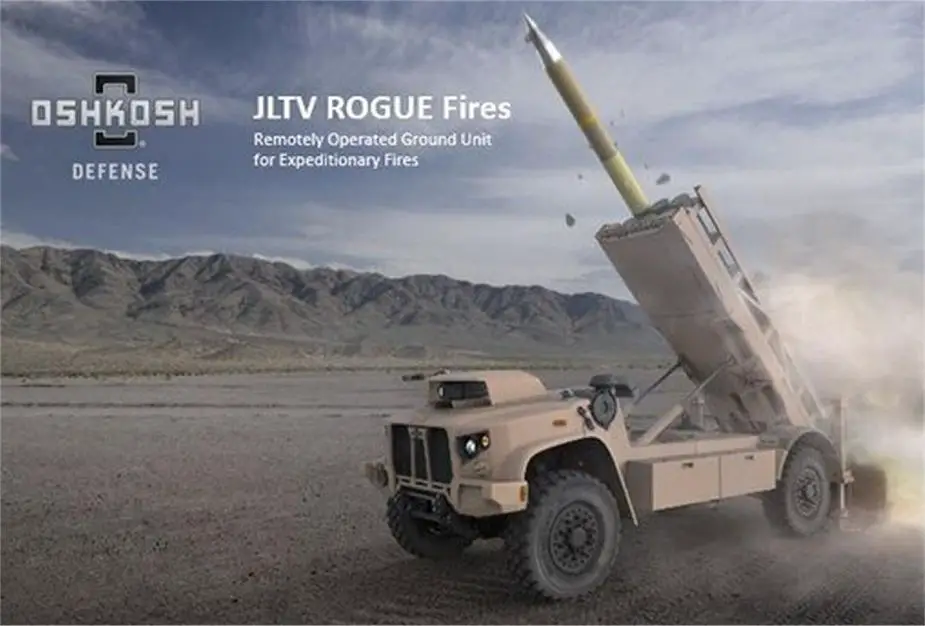Breaking news
US Marines plans to integrate Naval Strike Missile on unmanned JLTV ROGUE Fires vehicle.
The U.S. Marine Corps has launched a plan to integrate the Naval Strike Missile (NSM) on unmanned JLTV ROGUE Fires vehicle to enhance its anti-ship capability in support of sea control and sea denial missions. The development of a Ground-Based Anti-Ship Missile (GBASM) capability is the Marine Corps’ highest ground modernization priority.
Follow Army Recognition on Google News at this link

Drawing of JLTV ROGUE Fires using unmanned JLTV chassis fitted with NSM Naval Strike Missile launcher unit mounted at the rear of the vehicle. (Picture source Twitter)
The U.S. Marine Corps’ GBASM solution is the Navy Marine Expeditionary Ship Interdiction System (NMESIS), consisting of an unmanned JLTV-based mobile launch platform, called the ROGUE Fires, and Naval Strike Missiles (NSM) launcher unit.
The Joint Light Tactical Vehicle (JLTV) is being developed by the United States Army and the Marine Corps as a successor to the High Mobility, Multi-Wheeled Vehicle (HMMWV), which has been in service since 1985. On August 25, 2015, it was announced the Army had awarded Oshkosh a $6.7 billion low rate initial production (LRIP) contract with eight options to procure the initial 16,901 vehicles for the Army and Marines. The JLTV is being produced in Oshkosh, WI. The U.S. Marines could increase their JLTV requirement for a total of 9,091 JLTVs. The U.S. Air Force and Navy are also procuring a limited number of JLTVs for use.
According to the Department of the Navy’s 2021 budget book, the U.S. Marine Corps would like to use the existing armored vehicle JLTV and existing anti-ship missiles solution to create the Ground-based Anti-ship Missile and Remotely Operated Ground Unit Expeditionary (ROGUE) Fires vehicle.
The Navy/Marine Expeditionary Ship Interdiction System (NMESIS) will procure long term and short term solutions for an Anti-Ship Missile (ASM) capability in support of the Marine Corps Expeditionary Advanced Base Operations (EABO) and the National Defense Strategy approach to build a more lethal Joint Force. The NMESIS project will procure a USMC (United States Marine Corps) system while leveraging other Service-developed missiles to provide a ground-based anti-access/area denial, anti-ship capability.
The U.S. Marine Corps has shown interest for the Kongsberg/Raytheon Naval Strike Missile (NSM), an anti-ship and land-attack missile initially developed by the Norwegian company Kongsberg Defence & Aerospace. In 2018, the U.S. Navy selected the Naval Strike Missile for its over-the-horizon defense of littoral combat ships and future frigates. The USS Gabrielle Giffords (LCS 10) launched NSM in 2019 during Pacific Griffin, a biennial exercise conducted near Guam.
According to Raytheon, the NSM is also suited for land attack missions because it can climb and descend with the terrain. It was successfully tested in a land-based mobile launcher configuration in 2018 as part of a multination military exercise. In 2019, the U.S. Marine Corps integrated a land-based Naval Strike Missile into its force structure, sharing costs and interoperability with the Navy.
The airframe design and the high thrust to weight ratio give the NSM extremely good maneuverability. The missile is completely passive, has proven its excellent sea-skimming capabilities and with its advanced terminal maneuvers, it will survive the enemy air defences. The Autonomous Target Recognition (ATR) of the seeker ensures that the correct target is detected, recognized and hit, at sea or on land.
A first firing test of NMESIS was conducted in December 2019 and a second NSM live-fire is planned for June 2020.


























